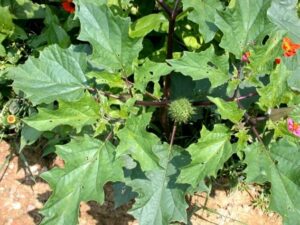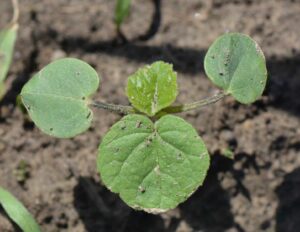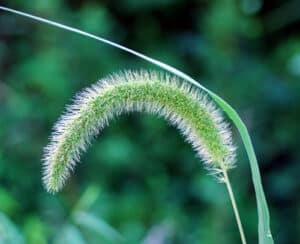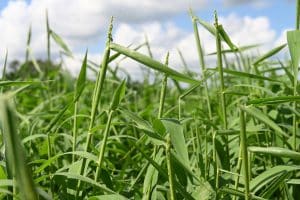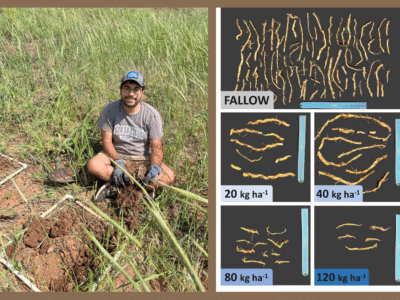Phytolacca americana L.
Also known as pokeberry, inkberry
Note: This information is based on experience in the Mid-Atlantic states; recommendations in other regions may vary.
Common pokeweed is a herbaceous simple (not creeping) perennial weed that has become a problem in agronomic crops in the Mid-Atlantic region, especially in no-till.
It is native to North America and can be found in most of the 50 states as well as Canada and Mexico. Common pokeweed will grow in wooded areas and along ponds, ditches, roads and fencerows; but more recently it has invaded Northeast farm fields and continues to spread. Traditionally, plowing was used to control common pokeweed. However, the widespread adoption of no-till along with a decline in the use of soil residual herbicides, especially in soybean, has likely allowed pokeweed populations to expand. Birds are believed to be the main mechanism of seed dispersal and seedling plants are often observed under trees or power lines where birds roost. An often-cited piece of information is that the seeds can remain viable for at least 40 years. The leaves, roots, and stems of pokeweed are poisonous to humans and livestock, although young pokeweed is edible if cooked. The toxin, called phytolaccatoxin, causes damage to the digestive, nervous, and respiratory systems and can result in death.
Identifying Features
Seedlings and mature plants have leaves and stems that are waxy and fleshy, without hairs. The leaves are alternate with petioles. Plants develop multiple branches that often become reddish in color. Mature plants can reach up to 10 feet in height with hollow stems. Plants will develop characteristic clusters of dark blue-back berries. Plants develop a thick tap-root (4 to 6 inches in diameter) that overwinters and develops into new plants the next year.

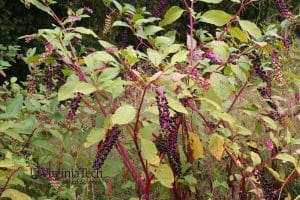
Seed Production
Unsure
Herbicide-Resistance
None Reported
Management
Common pokeweed is difficult to manage due to the large, persistent taproot and abundant seed production. Pokeweed is less of a problem in tilled systems. In addition, increasing the diversity of the crop rotation to include crops such as winter small grains and perennial forages will provide cultural and mechanical control options not available in corn and soybean. Plants originating from seeds are susceptible to the soil-applied herbicides clomazone, sulfentrazone, metribuzin, atrazine and cloransulam. Postemergence applications to plants emerging from overwintering roots are more susceptible when treated in mid-June or later. This is possibly due to increased herbicide translocation when pokeweed was flowering and starting to produce fruit.
Corn
Perennial pokeweed plants are difficult to control in corn, mostly due to limitations in herbicide application timing. POST or foliar herbicides are essential, as soil-applied herbicides are not effective on perennial plants. However, soil-applied residual herbicides can be important for seedling pokeweed control. Unfortunately, POST herbicides in corn are generally applied before pokeweed is most susceptible to control. Potentially effective herbicides in corn include the Group 4 growth regulator herbicides and Group 9 glyphosate. Group 2 or ALS inhibiting herbicides should be tank-mixed with a Group 2 or 9 herbicide to improve effectiveness. In addition, the Group 27 herbicide mesotrione has fair pokeweed activity when applied POST and can help provide control, particularly when tank-mixed with atrazine. Glyphosate is good for control of pokeweed depending on application timing.
Sorghum
Management of pokeweed in sorghum should be similar to corn and relies on POST systemic herbicides. Some of the same herbicides, except glyphosate, can be used in sorghum.
Soybean
The only effective soybean herbicide for control of common pokeweed is POST-applied glyphosate. Penn State tested a number of active ingredients primarily in the Group 2 or ALS inhibitor class and only glyphosate provided better than 60 percent control. Glyphosate application timing had the largest effect on pokeweed control, while nozzle selection, spray volume, and application rate were less important (full rates are still necessary). Application too early in the season is not effective. In Pennsylvania, glyphosate application after mid-June provided at least 90 percent control of pokeweed.
Small Grains
Pokeweed is only an issue in spring-seeded small grains, not winter grains. Some suppression can be obtained from the Group 4 or growth regulator herbicides, but these will generally need to be applied too early, before pokeweed is susceptible. Spring-seeded small grains are a good crop for managing pokeweed.
Perennial Forages
Perennial forages are an excellent crop for managing common pokeweed. In particular, established alfalfa that can be mowed four or more times per season will suppress pokeweed, and it is rarely a problem in these crops. Plant alfalfa in late summer to avoid pokeweed problems at establishment. In addition, a number of effective herbicides can be used to control pokeweed in perennial grass hay or pasture.
Fallow or Spot Treatment
Spot spray with glyphosate or use a Group 4 growth regulator herbicide for effective control. For best results, apply herbicides from bud to bloom and before fruit set.
This content was presented in the “Mid-Atlantic Field Crop Weed Management Guide” (2020), Penn State Ag Communications, AGRS-136
